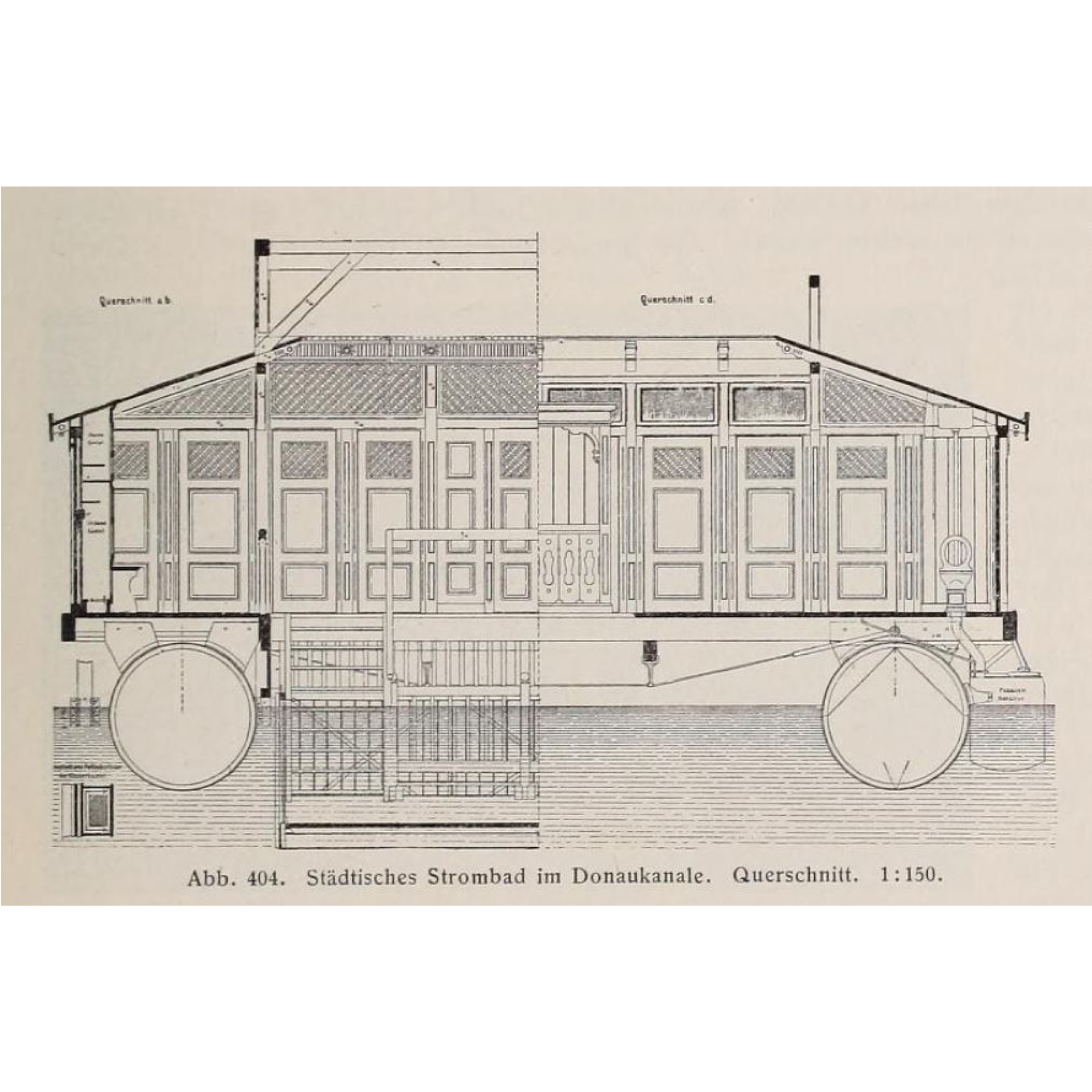
Public baths and saunas have been an integral part of the Viennese culture for centuries. The people of Vienna depended on public water for bathing, especially before the invention of indoor plumbing in their homes. Swimming in the Danube was extremely popular amongst the Viennese even before the 15th century; subsequently facing a decline with the ban on public swimming in the river to maintain hygiene with the rise of syphilis and plague.
The renewed change in attitudes with the Enlightenment period in the 18th century brought back the tradition of swimming with bathhouses and spas and recognized it as a measure for cleanliness, physical relaxation, and health betterment. The first cold water baths, affordable only to the wealthy, were constructed as floating ships on the Danube to raise physical defences. Soon, Vienna encountered a rise in public baths with free-of-charge baths built by the municipality of Vienna in 1799, the military swimming school in 1813, the first Austrian ladies' swimming school in 1831 before which women had no access to pools; and warm-water urban baths with a capacity of more than 1200 bathers in the Danube-regulation period between 1869-1875. By the mid 19th century, private bathing facilities with heated water similar to the Roman thermal baths were constructed. The Central Bathhouse, constructed in 1889 in the city centre, gained a lot of social reputation and is regarded as the oldest indoor bathing establishment of Vienna. River bathing boat facilities, 60 meters long and 10 meters wide, were constructed on the Danube canal in 1904 following the improvements in the sewage system of Vienna. The Amalienbad, a municipal indoor swimming pool with Art-Deco interiors, was built in 1926 and was "the largest and most modern bathing establishment in Central Europe".
Due to the numerous baths around the Old Danube, Vienna possessed an international reputation as "the city of baths" by the 1920s. However, many historic baths were destroyed during the Second World War. Efforts to rejuvenate them have been made ever since, especially following the implementation of the 1968 public bath concept with 14 pools to be built within a short period of seven years.
← Back to Lexicon
The renewed change in attitudes with the Enlightenment period in the 18th century brought back the tradition of swimming with bathhouses and spas and recognized it as a measure for cleanliness, physical relaxation, and health betterment. The first cold water baths, affordable only to the wealthy, were constructed as floating ships on the Danube to raise physical defences. Soon, Vienna encountered a rise in public baths with free-of-charge baths built by the municipality of Vienna in 1799, the military swimming school in 1813, the first Austrian ladies' swimming school in 1831 before which women had no access to pools; and warm-water urban baths with a capacity of more than 1200 bathers in the Danube-regulation period between 1869-1875. By the mid 19th century, private bathing facilities with heated water similar to the Roman thermal baths were constructed. The Central Bathhouse, constructed in 1889 in the city centre, gained a lot of social reputation and is regarded as the oldest indoor bathing establishment of Vienna. River bathing boat facilities, 60 meters long and 10 meters wide, were constructed on the Danube canal in 1904 following the improvements in the sewage system of Vienna. The Amalienbad, a municipal indoor swimming pool with Art-Deco interiors, was built in 1926 and was "the largest and most modern bathing establishment in Central Europe".
Due to the numerous baths around the Old Danube, Vienna possessed an international reputation as "the city of baths" by the 1920s. However, many historic baths were destroyed during the Second World War. Efforts to rejuvenate them have been made ever since, especially following the implementation of the 1968 public bath concept with 14 pools to be built within a short period of seven years.
← Back to Lexicon
Cross-Section of the Urban river bath in the Danube Canal. Scale 1:15.
Sources: Kortz, Paul, “Vienna at the beginning of the 20th century- A guide in a technical and artistic direction.”, Austrian Association of Engineers and Architects Vienna, Gerlach & Wiedling, 1906. Volume 2, 1905, p. 274, fig. 404, https://archive.org/details/wienamanfangdesx02kort/page/276/mode/2up?view=theater
Sources: Kortz, Paul, “Vienna at the beginning of the 20th century- A guide in a technical and artistic direction.”, Austrian Association of Engineers and Architects Vienna, Gerlach & Wiedling, 1906. Volume 2, 1905, p. 274, fig. 404, https://archive.org/details/wienamanfangdesx02kort/page/276/mode/2up?view=theater
- “Die ehemaligen Bäder am Donaukanal”, Link zur Startseite, accessed May 03, 2021, https://magazin.wienmuseum.at/die-ehemaligen-baeder-am-donaukanal
- “Where the Elites Bathed: Vienna's Central Bath”, Secret Vienna Tours, November 04, 2019, https://secretvienna.org/where-the-elites-bathed-viennas-central-bath/
-
“Central Bathhouse Vienna”, Wikipedia, April 21, 2021, https://en.wikipedia.org/wiki/Central_Bathhouse_Vienna
-
“Bäder”, – Wien Geschichte Wiki, accessed May 03, 2021, https://www.geschichtewiki.wien.gv.at/B%C3%A4der
